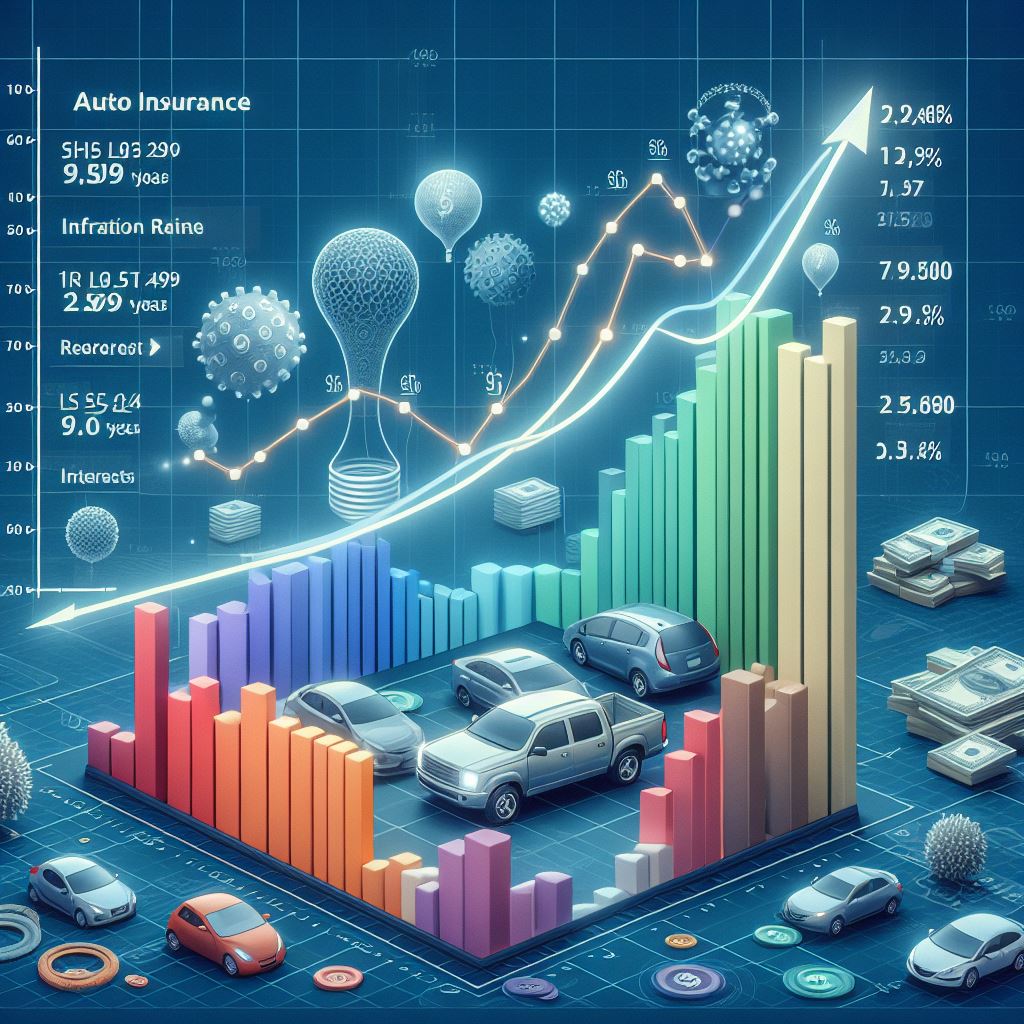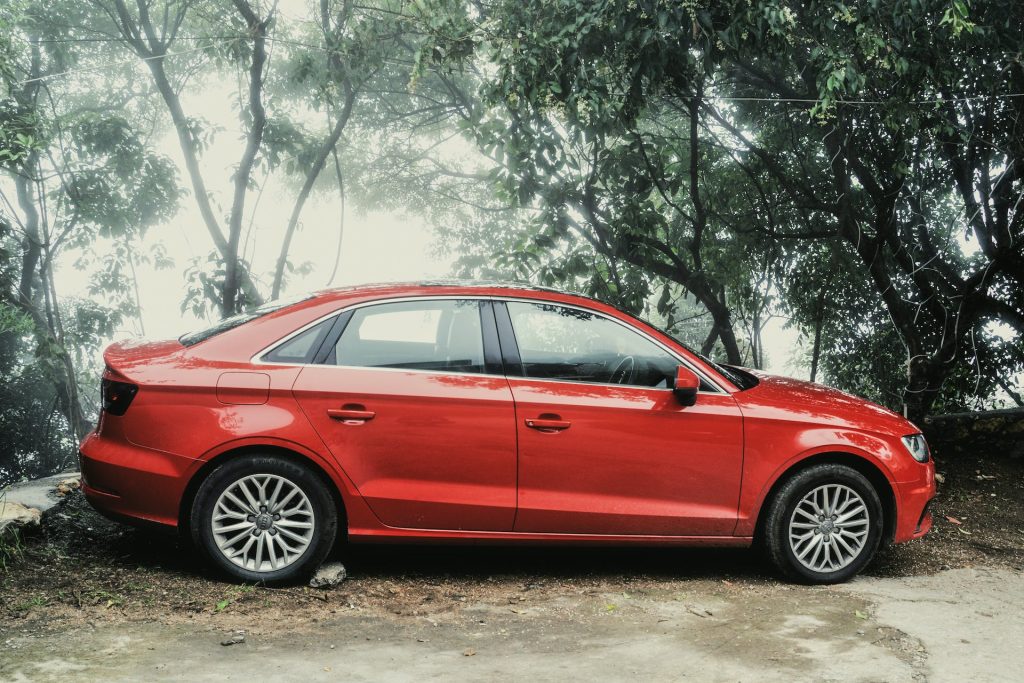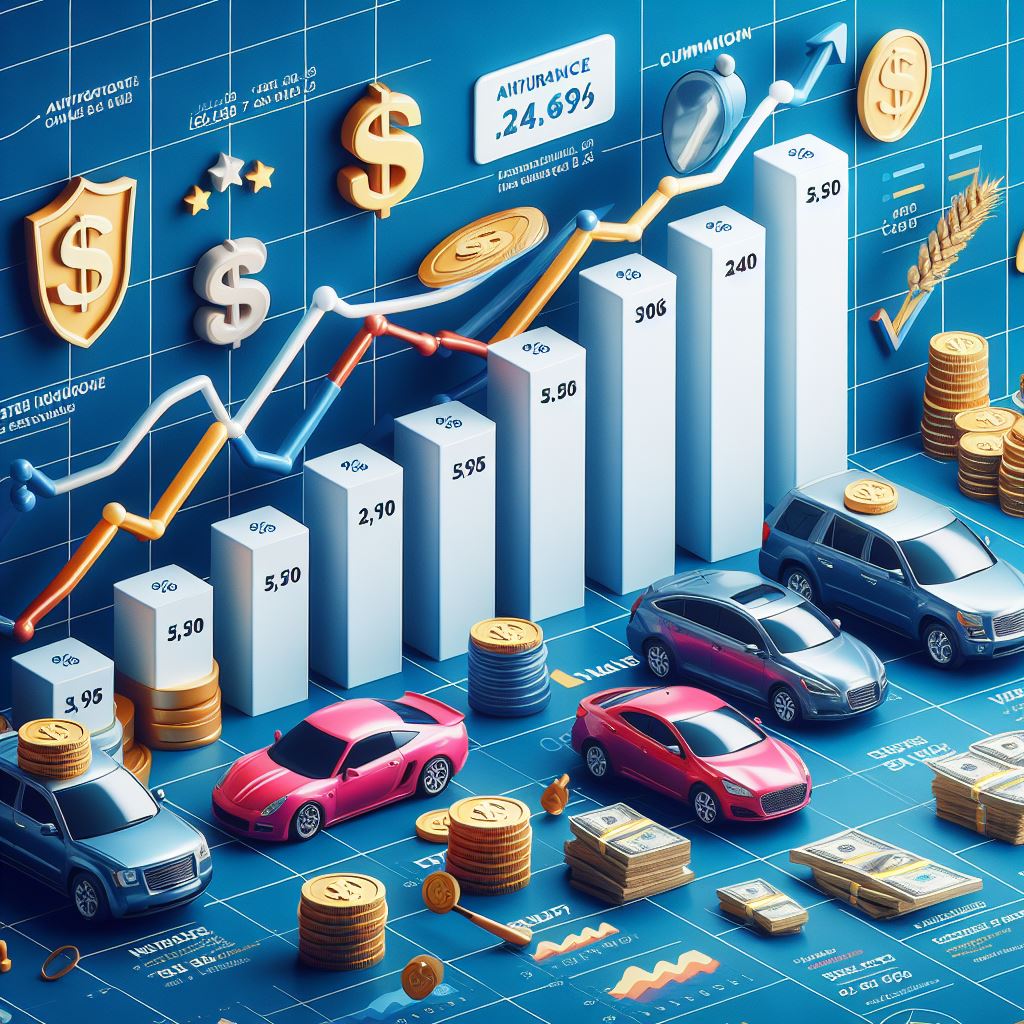
Get Ready for Higher Costs: Why Auto Insurance Rates Are Heading Skyward
The road ahead for auto insurance rates is anything but smooth. Across the country, 2024 is shaping up to be a year of significant premium increases, with some states facing the brunt of the financial squeeze. But before we dive into the specifics, follow along as CheapInsurance.com unpacks the reasons behind this nationwide hike. Remember, don’t gamble with your peace of mind, secure the safety net of cheap insurance before life throws a curveball.
Key Takeaways:
- Red Zone Warning: States like Missouri face the brunt of premium increases, while others see more modest changes. Consider location and driving habits when comparing quotes.
- Cost Driver Collision: Rising accident rates, medical inflation, and supply chain issues are pushing up repair costs and impacting your premium.
- Proactive Defense: Shop around, adjust coverages, and explore usage-based options to minimize the impact of rate hikes.
- Silver Lining Ahead: New technologies like telematics and shared mobility offer potential for future cost reductions and more personalized coverage.
- Knowledge is Power: Stay informed about trends, utilize resources, and compare quotes to become a savvy insurance consumer and find the best coverage for your needs.
A Perfect Storm of Cost Drivers:
Several factors are conspiring to push auto insurance costs higher:
- Rising Accident Rates: Unfortunately, the number of car accidents is on the rise, fueled by factors like distracted driving, increased traffic congestion, and higher speeds on open roads. This translates to more claims for insurers to pay out, driving up the overall cost of coverage. (Source: National Highway Traffic Safety Administration)
- Soaring Repair Costs: The price of fixing a damaged car has skyrocketed. Supply chain disruptions for parts, coupled with rising labor costs and the increasing complexity of modern vehicles, make repairs significantly more expensive. This translates to higher claims costs for insurers, which ultimately get passed on to policyholders. (Source: Insurance Information Institute)
- Medical Inflation: The cost of medical care, a significant component of accident claims, continues to outpace general inflation. This means that even relatively minor injuries can result in hefty bills for insurers, further contributing to the rise in premiums. (Source: Centers for Medicare & Medicaid Services)
- Natural Disasters: The frequency and intensity of extreme weather events like hurricanes and floods are on the rise. These events can cause widespread vehicle damage and lead to a surge in claims, again impacting insurance rates. (Source: National Oceanic and Atmospheric Administration)
The Ripple Effect:
These cost drivers create a domino effect within the insurance industry. As claims expenses rise, insurers need to increase premiums to maintain their financial solvency. This, in turn, puts a financial burden on policyholders, making car ownership even more expensive.
While the outlook may seem bleak, understanding the reasons behind the rate increases can help you make informed decisions about your own auto insurance coverage. In the next section, we’ll delve deeper into the specific states facing the highest premium hikes and explore what this means for drivers.
The Red Zone: States Facing the Largest Auto Insurance Rate Jumps
Prepare for sticker shock, because some states are facing astronomical auto insurance premium hikes in 2024. While the cost is rising everywhere, certain hotspots deserve a red warning label.
Missouri Leads the Charge:
Taking the dubious crown is Missouri, with an average full coverage premium increase of 38.2% year-over-year. This means a driver who paid $1,000 for full coverage in 2023 could see their premium balloon to $1,382 in 2024 – a significant jump! Several factors contribute to Missouri’s misfortune, including:
- Distracted Driving Epidemic: The state consistently ranks high in distracted driving incidents, leading to more accidents and higher claims costs. (Source: AAA Foundation for Traffic Safety)
- Soaring Medical Costs: Missouri healthcare costs are rising faster than the national average, making even minor injuries expensive for insurers. (Source: Kaiser Family Foundation)
- Severe Weather Impact: The state’s susceptibility to storms and floods often results in widespread vehicle damage and insurance claims. (Source: National Centers for Environmental Information)
Other Notable Red Zones:
Missouri isn’t alone in its insurance woes. Joining the top five states with the highest rate hikes are:
- Ohio (15.1% increase)
- Illinois (12.4% increase)
- New York (11.5% increase)
- Tennessee (10.8% increase)
Similar factors like high accident rates, rising medical costs, and natural disaster risks play a role in each of these states, pushing premiums upward.
To learn more about auto insurance in each state, find your state on our auto insurance locations in the United States resource page.
Diving Deeper: Regional Disparities and Their Causes
The national map of auto insurance rate increases paints a picture of regional disparity. While some states grapple with significant hikes, others see relatively modest changes.
Urban vs. Rural Divide:
Location plays a big role in determining your premium. Generally, urban areas experience higher rates than rural areas. Here’s why:
- Concentration of Drivers: Densely populated cities naturally see more traffic, increasing the risk of accidents and claims.
- Crime Rates: Higher crime rates in urban areas can lead to car thefts and vandalism, raising insurance costs.
- Repair Costs: Urban repair shops often charge more than their rural counterparts.
However, exceptions exist. Some rural states with high accident rates or susceptibility to natural disasters could see premiums comparable to urban areas.
Understanding the Nuances:
It’s important to remember that these are general trends. Individual rates can vary significantly within each state and city based on driving history, type of car, and other factors.
Urban vs. Rural Drivers: How Location Impacts Your Premium
Whether you navigate city streets or rural highways, your location significantly impacts your auto insurance premium. Here’s a breakdown:
Urban Drivers:
- Expect higher rates: The factors mentioned earlier – congested traffic, higher crime rates, and costly repairs – contribute to higher premiums for urban drivers.
- Shop around: Competition among insurers can be fierce in cities, offering potential for finding better deals.
- Consider usage-based insurance: Pay-per-mile programs can benefit low-mileage urban drivers.
Rural Drivers:
- Generally lower rates: Less traffic, lower crime rates, and potentially cheaper repairs translate to lower premiums for rural drivers.
- Limited options: Fewer insurers might operate in rural areas, impacting competition and potentially reducing your bargaining power.
- Traditional coverage might be best: Usage-based plans may not offer significant savings due to lower mileage in rural areas.
Remember, location is just one factor influencing your rate. Always consider your driving habits, vehicle type, and other variables when comparing insurance options.
By understanding the reasons behind the disparities and your unique situation, you can make informed decisions about your auto insurance coverage and navigate the 2024 rate rollercoaster effectively.

Behind the Curtain: What’s Making Your Coverage More Expensive?
The rising cost of auto insurance isn’t just a number on your bill; it’s a consequence of several intertwining factors pulling your premium upwards. Let’s peel back the layers and examine the key cost drivers:
Crash Course in Claims: Rising Accident Rates and Medical Inflation
A Collision of Cars and Costs: Unfortunately, accident rates are on the rise across the nation. Distracted driving, speeding, and increased traffic congestion all contribute to this upward trend. (Source: National Highway Traffic Safety Administration: https://www.nhtsa.gov/) Each fender bender translates to insurance claims, driving up overall costs for the industry and ultimately impacting your premium.
Medical Bills that Multiply: When accidents happen, injuries follow. The rising cost of medical care, outpacing general inflation, adds another layer of financial burden to insurance companies. Even minor injuries can result in hefty medical bills, impacting claims significantly. (Source: Centers for Medicare & Medicaid Services: https://data.cms.gov/) This translates to higher premiums for all policyholders, as insurers seek to balance their books.
Supply Chain Squeeze: How Vehicle Repair Costs Play a Role
The Price of a Dent: Even a minor collision can lead to major repair bills. Supply chain disruptions have made obtaining car parts difficult and expensive, pushing repair costs skyward. Additionally, the increasing complexity of modern vehicles makes them more challenging and expensive to fix. (Source: Insurance Information Institute: https://www.iihs.org/) These factors add another layer of burden to insurance claims, ultimately impacting your premium.
A Perfect Storm of Cost Drivers:
Rising accident rates, medical inflation, and supply chain issues create a perfect storm for increasing insurance costs. Each factor adds its own pressure, squeezing insurers and ultimately leading to higher premiums for drivers. Understanding these cost drivers empowers you to make informed decisions about your coverage and potentially find ways to mitigate the impact on your wallet.

Looking Ahead: Navigating the Uncertain Terrain of Auto Insurance Costs
With auto insurance rates soaring in 2024, the question everyone asks is: “When will it stop?” Predicting future trends is always tricky, but here’s what we can expect:
Is There a Plateau in Sight?
Experts predict a gradual slowdown in rate increases in 2025 and 2026, but a complete leveling off is unlikely. Rising medical costs and ongoing supply chain issues will likely keep upward pressure on premiums. Some states might see more significant deceleration than others, depending on their specific risk factors and regulatory environments. (Source: Fitch Ratings: https://www.fitchratings.com/)
Proactive Defense: Tips for Minimizing the Impact of Rate Hikes
While we can’t control all the factors driving up insurance costs, proactive steps can help minimize the impact on your wallet:
- Shop around: Compare quotes from different insurers. Loyalty doesn’t always pay off! Look for discounts based on driving habits, good credit scores, and bundling policies. (Source: Consumer Reports)
- Adjust your coverage: Review your policy and adjust coverages to match your needs. Do you need comprehensive coverage on an older car? Explore options like higher deductibles to lower premiums.
- Consider usage-based insurance: If you’re a low-mileage driver, pay-per-mile programs can offer significant savings. Be sure to understand the program’s terms and conditions to avoid surprises.
The Silver Lining: Alternatives and Innovative Solutions for Drivers
Despite the challenges, the auto insurance industry is constantly evolving. New technologies and risk-based models offer promise for the future:
- Telematics: Devices that track your driving behavior can lead to personalized rates based on individual risk. This reward safe drivers and potentially lower their premiums.
- Shared mobility: The rise of car-sharing and ride-hailing services could reduce car ownership and insurance needs, impacting the traditional insurance market.
- Autonomous vehicles: The future of self-driving cars holds potential for safer roads and, possibly, lower insurance costs due to reduced accident rates.
While these solutions are still in their early stages, they represent a beacon of hope for a more affordable and equitable future in the auto insurance landscape.
Remember, knowledge is power. By staying informed about the factors driving up rates and exploring available options, you can navigate the rising tide of auto insurance costs and find the best coverage for your needs and budget.
Actionable Steps: Take Control of Your Auto Insurance Future
With the dust settled on the reasons behind rising auto insurance costs in 2024, it’s time to shift gears and focus on what you can do. Here’s your roadmap to navigating the changing landscape:
Check Your State’s Standing:
Remember those red zones we mentioned earlier? Find out where your state falls on the map of rate increases. Several resources can help, including:
- The Insurance Information Institute: This national organization offers a state-by-state breakdown of average premium increases
- Your State Insurance Department: Many state insurance departments provide data on average rates and consumer resources.
- Independent Rating Agencies: Companies like S&P Global and Fitch Ratings offer insights into insurance industry trends and state-specific risk profiles.
Knowing your state’s position gives you a clearer picture of the potential impact on your premium and helps you prepare effectively.
Comparison Shopping Spree:
Don’t settle for the first quote you get. Embrace your inner bargain hunter and explore your options:
- Get quotes online: Numerous online insurance marketplaces allow you to compare quotes from multiple companies simultaneously.
- Contact independent agents: These agents represent various insurers, offering wider coverage options and potential for personalized attention.
- Don’t forget traditional insurers: Big-name insurance companies might still offer competitive rates, especially with bundled policies or discounts.
Remember, the cheapest option isn’t always the best. Consider factors like coverage levels, customer service reviews, and the company’s financial stability.
Stay Informed: Resources and Tips for Navigating the Changing Landscape:
Knowledge is your best weapon against rising costs. Keep your finger on the pulse with these resources:
- Consumer advocacy groups: Organizations like the National Association of Insurance Commissioners (NAIC) offer consumer guides and advocacy resources.
- Industry publications and blogs: Stay updated on trends and news with resources like Insurance Journal and Property Casualty 360.
- Your insurance company: Don’t hesitate to reach out to your insurer with questions or concerns about coverage options or rate increases.
Staying informed empowers you to make informed decisions, adjust your coverage as needed, and adapt to the evolving landscape of auto insurance.
Remember, rising auto insurance costs don’t have to derail your budget. By being proactive, doing your research, and taking advantage of available resources, you can find the best coverage for your needs and minimize the impact of rate hikes.

Path to a Brighter Future: Mastering the Road of Auto Insurance
The road ahead for auto insurance might seem bumpy, with rising costs casting a shadow on your budget. But remember, you’re not just a passenger on this journey; you’re the driver. By understanding the forces driving the increase, equipping yourself with knowledge, and taking proactive steps, you can navigate the changing landscape with confidence.
Don’t let the fear of a higher premium paralyze you. Instead, embrace the opportunity to become a savvy insurance consumer. Compare quotes, explore innovative coverage options, and leverage resources to find the best deal for your needs. Remember, knowledge is power, and a little research can go a long way in saving you money.
More than just a financial decision, navigating rising costs is a chance to take control of your auto insurance journey. By staying informed, reviewing your coverage regularly, and adjusting as needed, you’ll be prepared for whatever bumps the road throws your way.
So, grab your research tools, and get ready to navigate the changing terrain of auto insurance. Remember, with knowledge, proactive action, and a little savvy, you can turn this challenge into an opportunity to master the road and find affordable coverage that protects you and your loved ones.
Related Reading:
Are Vehicle Touchscreens Safe or a Distraction?
Ridesharing to Robocars: Emerging Mobility Trends and Their Impact on Auto Insurance
Eco-Friendly Car Choices that Boost Your Auto Insurance Discounts
Does Auto Insurance Cover a Rental? Find Out Before A Claim
How Telematics is Transforming Auto Insurance for Safe Drivers
5 Unexpected Coverages Your Auto Insurance Might Offer
How auto insurance rates have changed over the past decades
7 Factors That Affect Your Car Insurance Rate
How Often Do You Pay For Car Insurance?
Cheap Car Insurance Online Get Affordable Auto Insurance Quotes


